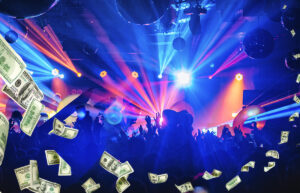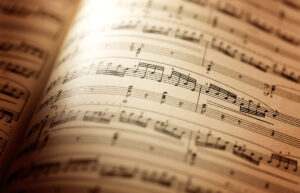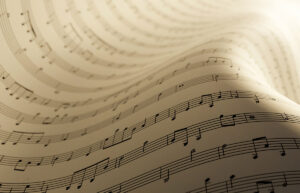What is EDM Music: Meaning, Elements, Festivals & Top Artists

Welcome to the rhythmic universe of electronic dance music (EDM)! Uncover beats, history, and evolving trends of EDM. From the birth of the genre from house and techno music to the influential artists shaping its present, we journey through the features, fundamental elements, and the music structure of EDM. Join us as we explore the top beats that make you move, the concerts and music festivals, the impact of EDM on the entertainment industry, and the future innovations in the EDM realm. Let’s embark on a musical adventure!
Welcome to TheDemoStop, now join the community!
Connect with artists, fans and producers around the world.
What is EDM?
EDM is a broad term for various electronic music genres primarily produced for dance-based entertainment and nightlife settings. EDM includes genres such as house, techno, trance, dubstep, and more and incorporates the use of electronic technology in music production, often involving synthesizers, drum machines, and digital audio workstations. The music is designed to have strong beats and drops, making it popular in clubs, festivals, and other dance events.
A brief history of EDM
Birth of EDM
- Dates: Late 1970s to early 1980s
- Pioneers: Giorgio Moroder, Kraftwerk
- Birth Location: Germany, Italy, United States
In the late 1970s, electronic music underwent a transformative period, with artists such as Giorgio Moroder and Kraftwerk pushing the boundaries of music production. Giorgio Moroder is renowned for his work on Donna Summer’s “I Feel Love” (1977), a track that utilized synthesizers and electronic sounds, setting the stage for the electronic dance sound. Kraftwerk, a German band, played a crucial role with their pioneering use of synthesizers and electronic instruments, influencing countless musicians.
Rise of EDM music
- Dates: 1980s to 1990s
- Pioneers: Juan Atkins, Derrick May, Frankie Knuckles
- Birth Location: Detroit (Techno), Chicago (House)
In the 1980s, the electronic dance scene gained momentum with the emergence of distinct genres such as techno in Detroit because of visionaries such as Juan Atkins, Derrick May, and Kevin Saunderson and house in Chicago, pioneered by disc jockey (DJs) and producers such as Frankie Knuckles. House and techno became the pillars of the EDM movement, setting the stage for its global rise. Drum machines, synthesizers, and early samplers became the defining characteristics of this new musical landscape.
1970s: Rise of disco
- Dates: Late 1970s
- Pioneers: Giorgio Moroder, Donna Summer
- Birth Location: United States
Although not exclusively EDM, the late 1970s saw the rise of disco, a genre that heavily influenced electronic dance music. Giorgio Moroder’s production work on Donna Summer’s disco hits, such as “I Feel Love,” showcased the potential of electronic sounds in creating danceable and futuristic music, laying the groundwork for EDM.
Reigning at raves
- Dates: Late 1980s to 1990s
- Pioneers: The Prodigy, Orbital, Underworld
- Birth Location: United Kingdom
The late 1980s and 1990s witnessed the explosion of EDM in the form of raves, especially in the United Kingdom. Artists such as The Prodigy, Orbital, and Underworld created music that became anthems for large-scale dance events. The rave culture significantly contributed to the globalization and popularization of EDM, marking it as a cultural phenomenon.
Basic elements of EDM
Four-beat measure kick
The four-beat measure kick is an essential element in EDM, providing the rhythmic backbone for the music. In electronic dance music, the kick drum typically follows a 4/4 time signature, that is, four beats in a measure. A kick drum creates steady and driving music. This consistent and predictable pattern makes a strong and entertaining track that connects with dancers and listeners, allowing them to follow the music easily.
Bass drums
Bass drums, often called “kicks,” are a vital component of EDM’s sound palette. These drums provide a powerful, low-frequency thump that sets the rhythm of the music. In EDM, the kick drum is often heavily manipulated, featuring attack and a sustained deep resonance. This unique sound not only moves the beat along but also contributes to the overall energy and intensity of the track. Through careful mixing and production techniques, EDM producers make the bass drums stand out through the mix and become a driving force on the dance floor.
Downbeat
The downbeat is a critical element in music, representing the first beat of each measure. In a 4/4 time signature, the downbeat falls on the first and third beats of the bar. The downbeat is a reference point often emphasized in EDM to reinforce the rhythmic structure. The downbeat provides stability and helps establish the tempo, allowing dancers to synchronize their movements with the music. EDM stresses on the downbeat to create a rhythmic structure so that the listeners can follow along. The downbeat stabilizes and sets the tempo, helping dancers match the music.
Welcome to TheDemoStop, now join the community!
Connect with artists, fans and producers around the world.
Characteristics of EDM
Heavy use of electronic instruments
EDM uses extensive electronic instruments, from synthesizers and drum machines to Digital Audio Workstations (DAWs). These instruments allow producers to create various unique and futuristic sounds that define the genre. The manipulation of electronic elements provides EDM with a different sound mix, setting it apart from traditional music genres and enabling artists to craft innovative and experimental compositions.
Fast tempo
A common trait of EDM is its fast tempo, which contributes to the genre’s energetic nature. The beats per minute (BPM) of EDM tracks can vary, but they generally fall within a higher range, often exceeding 120 BPM. The increased tempo not only makes the music more enjoyable to dance to but also adds to the intensity and excitement experienced by the audience.
Repetitive beats
Repetitive beats are a hallmark of EDM, contributing to its hypnotic and trance-inducing qualities. The consistent rhythm, often maintained throughout a track, creates a sense of continuity and encourages a seamless flow on the dance floor. Repetition is a powerful tool in EDM, contributing to the genre’s ability to maintain high energy and attention among listeners.
Emphasis on bass
The emphasis on bass in EDM helps producers craft powerful and distinctive basslines. The bass provides depth and intensity to the music, creating a real and tangible experience for listeners.
Builds and drops
EDM frequently employs characteristic high builds and low drops to create hype and release. Builds involve a gradual increase in tension and energy with rising melodies or intensifying beats, whereas drops represent the climax of the build, where the full sonic force is unleashed, creating an exhilarating and euphoric moment for the audience. This structural technique creates an emotional impact on many EDM tracks.
Use of effects
EDM producers use various effects, including filters, delays, reverbs, and modulation, to shape and manipulate sounds. These effects contribute to the genre’s complexity, creating an otherworldly atmosphere and allowing producers to create an ever-evolving sound atmosphere.
Use of samples
Sampling is an extremely common technique in EDM. Music producers incorporate snippets of existing recordings into their tracks, including voice samples, sound effects, or musical elements from various genres. Sampling allows producers to add a layer of familiarity or nostalgia to their compositions while providing a unique and creative twist.
Uniqueness
One of the strengths of EDM lies in its ability to evolve and embrace new sounds and styles constantly. Producers often strive for uniqueness by experimenting with unconventional sounds, pushing boundaries, and incorporating diverse influences.
Bass drums
Bass drums, called kick drums or kicks, drive the music in EDM. These drums provide the powerful and driving beats that characterize the genre. In addition to maintaining the rhythm, bass drums are crafted and equalized to ensure they cut through the mix and deliver a punchy and impactful sound.
High hat kicks
High hat kicks, produced by hi-hat cymbals on a drum kit or equivalent synthesizer, contribute to the complex sound patterns in EDM. The spontaneous and aggressive elements in the beats enhance the overall groove and energy of the music.
Claps
In EDM music, claps make a sharp sound that fits the beat. They often go along with the kick drum, making the music feel like it’s moving forward and adding to the overall drumbeat.
Melody
Although EDM is known for its rough and bold elements, melody remains a crucial component. In EDM songs, the tunes played by instruments such as synthesizers or recorded sounds make the music feel deeper. These tunes can be happy and big or soft and calming, and when they mix with the beats, it makes the music more exciting.
Welcome to TheDemoStop, now join the community!
Connect with artists, fans and producers around the world.
Song structure of EDM music
Intro
The intro is the welcome mat of an EDM song. The music sets the stage for what’s to come. Usually, it’s a bit calmer, introducing some of the main elements you’ll hear later. This part helps listeners ease into the vibe and prepares them for the energy about to hit.
Verse/main
The verse is like the song’s heart, where you often hear the lyrics or the main melody. Think of the verse as the anchor, holding everything together. The verse is often repeated.
Build
The excitement starts to build up here. The build is like climbing a musical staircase—the energy and intensity increases, usually with rising beats or melodies. You can feel something big is on the way, and it keeps you hooked, building up your anticipation to the next element of the song.
Drop
Boom! The drop is the big, energetic moment everyone’s been waiting for. It’s like the peak of a rollercoaster ride. Here, the bass kicks in, beats hit hard, and the music explodes. It’s the part that makes you want to dance, jump, or deeply feel the music.
Breakdown
After all that excitement, there’s a moment to catch your breath. The breakdown is a bit quieter and calmer. It’s like the song pausing for the next big thing. Sometimes, you hear a stripped-down version of the melody, preparing you for the next round of energy.
Most popular EDM genres
| Genre | Description | Notable Songs | Key Artists | Origin |
| House | Upbeat, dance-oriented music with repetitive beats | “I Gotta Feeling” – Black Eyed Peas | Daft Punk, Frankie Knuckles, Disclosure | Chicago, USA |
| Techno | Characterized by a repetitive four-on-the-floor beat | “Strings of Life” – Derrick May | Jeff Mills, Carl Cox, Richie Hawtin | Detroit, USA |
| Trance | Emphasizes an intense and melodic buildup and release | “Adagio for Strings” – Tiësto | Armin van Buuren, Paul van Dyk, Above & Beyond | Germany (Frankfurt) |
| Dubstep | Heavy bass and syncopated rhythmic patterns | “Scary Monsters and Nice Sprites” – Skrillex | Skrillex, Benga, Coki | London, UK |
| Drum and Bass | Fast-paced with syncopated breakbeats and heavy bass | “Tarantula” – Pendulum | Pendulum, Noisia, Andy C | UK (Bristol) |
| Electro | Features a heavy use of synthesizers and robotic sounds | “Ghost ‘n’ Stuff” – Deadmau5 | Deadmau5, Justice, The Chemical Brothers | Global (Originated in Europe) |
| Ambient | Atmospheric, often instrumental music with a relaxing vibe | “Music for Airports” – Brian Eno | Brian Eno, Aphex Twin, Enigma | Global |
| Chill House | Blends the rhythmic elements of the house with a relaxed vibe | “Strobe” – Deadmau5 | Kygo, Nora En Pure, Lane 8 | Global |
| Deep House | Slower tempo with soulful vocals and a deeper, smoother sound | “Show Me Love” – Robin S | Kerri Chandler, Larry Heard, Maya Jane Coles | Chicago, USA |
Reasons for EDM’s popularity
EDM has countless subgenres
One reason for EDM’s popularity is its incredible diversity. From house to techno, trance to dubstep, there’s a subgenre for every taste. This variety allows EDM to cater to a broad audience, attracting music lovers with different preferences and creating a rich and inclusive musical landscape.
EDM is ideal for festivals, concerts, and nightclubs
The energetic and danceable nature of EDM makes it a perfect fit for live events. Whether it’s a massive festival, an intimate club, or a concert, EDM’s beats and drops create an immersive experience that resonates with a live audience. Dancing together to the beats of EDM amplifies the enjoyment at these events.
EDM brings people together
EDM has a unique ability to bring people from different backgrounds together. The shared experience of dancing to the same beats creates a sense of unity and connection. Festivals, in particular, become a melting pot of cultures and individuals, all united by their love for electronic dance music.
EDM has no language barriers
Unlike some music genres where language can be a barrier, EDM relies heavily on instrumental and rhythmic elements, making it universally accessible; you don’t need to understand specific lyrics to feel the energy and vibe. It’s a global language that transcends linguistic boundaries.
EDM can be produced by anyone
The accessibility of music production tools in the digital age has democratized the creation of EDM. Anyone with a computer and creativity can produce electronic music. This openness has led to a surge in new talent, allowing diverse voices and perspectives to contribute to the genre’s evolution.
Electronic music allows you to produce something unique
The vast array of electronic instruments and production techniques empowers artists to craft unique sounds. EDM encourages experimentation, pushing of boundaries, and creating innovative compositions. This freedom allows artists to express their individuality, contributing to the genre’s constant evolution.
EDM mixing with pop vocals is a powerful combination
The fusion of EDM beats with pop vocals has proven to be a winning combination. It brings the genre into mainstream consciousness, making it accessible to a broader audience. This crossover has resulted in chart-topping hits, expanding EDM’s reach and solidifying its position in popular music culture.
Impact of EDM music on society
All walks of life
EDM’s impact on society is profound and cuts across demographic boundaries. The genre’s universal appeal draws in people from all walks of life, transcending age, nationality, and cultural background. The inclusive nature of EDM events fosters a sense of community where diverse individuals come together to celebrate music and dance, contributing to a more connected and harmonious society.
Influence on fashion and culture
EDM has significantly influenced fashion trends and cultural expression. The vibrant and eclectic styles seen at EDM events often become mainstream fashion. The colorful, avant-garde outfits, often characterized by bold prints, out-of-the-box elements, and unique accessories, reflect the free-spirited and experimental ethos of the EDM culture. The influence extends beyond clothing by seeping into art, design, and even lifestyle choices, shaping a distinctive subculture with a global impact.
Contribution to the growth of music festivals
EDM has played a pivotal role in the surge of popularity of music festivals worldwide. EDM-centric festivals, such as Tomorrowland, Ultra Music Festival, and Electric Daisy Carnival, have become iconic cultural phenomena. These events draw massive crowds, fostering a sense of collective celebration. The success of EDM at festivals has influenced the programming of other festivals, incorporating electronic music acts into their lineups showcasing the genre’s impact on the broader music festival landscape.
Welcome to TheDemoStop, now join the community!
Connect with artists, fans and producers around the world.
Seven biggest EDM Events and Festivals.
Tomorrowland

- Location: Boom, Belgium
- Signature: Known for its extravagant stage designs and immersive themes.
- Global reach: Live-streamed globally, allowing millions to participate virtually.
- Scale: One of the largest and most iconic festivals, attracting top EDM artists.
Ultra Music Festival (UMF)

- Location: Miami, Florida, with global editions in various cities.
- Signature: High-energy performances, cutting-edge production, and premiering new tracks.
- Innovation: Pioneers in introducing advanced production technology to the festival scene.
- Global impact: Hosts events in multiple countries, including Europe and Asia.
Electric Daisy Carnival (EDC)

- Location: Various cities, including Las Vegas, Orlando, and Mexico City.
- Signature: Iconic for its carnival atmosphere, massive stage setups, and vibrant visuals.
- Inclusivity: Embraces various electronic music subgenres, attracting a diverse audience.
- Experience: Renowned for its immersive and electric ambiance, creating a surreal world for attendees.
Creamfields

- Location: Daresbury, Cheshire, United Kingdom, with international editions.
- Legacy: One of the oldest and most influential electronic music festivals globally.
- Diversity: Showcases a broad spectrum of electronic genres, catering to varied tastes.
- Global expansion: Expanding to other countries, maintaining its status as an EDM institution.
Electric Zoo

- Location: New York City, Randall’s Island Park.
- Urban EDM experience: Stands out as a major electronic music festival in the heart of NYC.
- Innovation: Features cutting-edge stage designs and a diverse lineup of global talent.
- Community: Draws both local and international EDM enthusiasts.
Amsterdam Dance Event (ADE)

- Location: Amsterdam, Netherlands.
- Industry focus: A festival and a global platform for electronic music professionals.
- Networking: Bring together artists, industry leaders, and fans for conferences, workshops, and events.
- Celebration of electronic culture: Combines a festival atmosphere with discussions on the industry’s future.
Electric Forest

- Location: Rothbury, Michigan, USA.
- Unique setting: This festival takes place in a magical forest, offering a distinctive and immersive experience.
- Community spirit: Focused on fostering community among attendees.
- Diversity: Features a diverse lineup spanning various electronic music genres.
Seven top EDM musicians
Avicii

- Legacy: Renowned for his melodic and uplifting tracks, leaving a lasting impact on EDM.
- Hits: “Wake Me Up” and “Levels” are iconic songs that achieved mainstream success.
- Innovation: Known for blending various genres and creating a distinctive sound.
Marshmello

- Mystery persona: Recognized by the signature marshmallow helmet, maintaining anonymity.
- Versatility: Creates a mix of energetic and melodic tracks, appealing to a broad audience.
- Collaborations: Collaborated with artists of several genres, bridging the gap between EDM and popular music.
Skrillex

- Dubstep pioneer: Instrumental in popularizing dubstep globally, earning multiple Grammy Awards.
- Genre fusion: Known for combining various electronic genres and pushing boundaries.
- Production skill: Acclaimed for intricate and experimental production techniques.
Martin Garrix

- Prodigy: Achieved global fame at a young age, known for hits like “Animals” and “Scared to be Lonely.”
- Consistency: Maintains a strong presence with consistent releases and high-energy performances.
- Industry recognition: Topped DJ Mag’s Top 100 DJs list multiple times.
David Guetta

- Crossover success: Successfully transitioned from underground to mainstream, blending EDM with pop.
- Hitmaker: Produced chart-topping hits such as “Titanium” and “Without You.”
- Longevity: Maintained relevance over decades, influencing the electronic music landscape.
Calvin Harris

- Chart dominance: Known for numerous chart-topping hits, including “Summer” and “Feel So Close.”
- Versatility: Skillfully navigates various electronic subgenres, incorporating pop elements.
- Commercial success: One of the highest-paid DJs globally, with widespread commercial success.
Deadmau5

- Iconic persona: Signature mouse-head helmet.
- Innovation: Pushes boundaries with experimental and complex compositions.
- Album concepts: Known for conceptual albums, creating immersive sonic experiences.
Welcome to TheDemoStop, now join the community!
Connect with artists, fans and producers around the world.
Future of EDM
Trends and innovations
- Genre fusion: Further blending of genres as artists experiment with diverse influences, creating hybrid sounds that transcend traditional boundaries.
- Immersive experiences: Continued emphasis on immersive live experiences, integrating advanced technologies like virtual reality (VR) and augmented reality (AR) to enhance audience engagement.
- AI in music production: Increasing the use of artificial intelligence (AI) in music production, from generating beats to assisting in composition, leading to novel and automated creative processes.
- Blockchain in music distribution: Adoption of blockchain technology for transparent and decentralized music distribution, providing fair compensation to artists and reducing intermediaries.
Sustainability and environmental concern
- Green initiatives: Festivals and events will likely prioritize sustainability, implementing eco-friendly practices, reducing carbon footprints, and promoting environmentally conscious behaviors among attendees.
- Renewable energy: Transition to renewable energy sources for powering events, reducing reliance on non-renewable resources.
- Waste reduction: Concerts and festivals aiming for zero waste, incorporating recycling programs, and minimizing single-use plastics.
Influence on musicians
- Do-it-yourself (DIY) culture: Continued rise of the DIY culture in music production, with artists independently creating and releasing music online.
- Global collaboration: Increased cross-cultural collaborations facilitated by digital platforms, enabling artists worldwide to collaborate seamlessly.
- Inclusive representation: Greater emphasis on diversity and inclusivity in the EDM scene, giving voice to artists from underrepresented backgrounds and fostering a more inclusive community.
- Activism through music: More musicians are using numerous platforms to address social issues, raise awareness, and contribute to positive change through their music and influence.
Conclusion
EDM is a widely popular music genre that enthralls listeners. With the digital era, streaming platforms will ensure that EDM will have massive outreach in the future.
EDM meaning: EDM is a broad music genre characterized by electronic instruments, technology-driven production, and a focus on creating music suitable for dance-based environments such as clubs, festivals, and raves.
EDM history:
- Dates of birth: Late 1970s to early 1980s
- Pioneers: Kraftwerk and Giorgio Moroder
- Place of birth: United States, Germany, or Italy
- Electronic music changed a lot in the late 1970s with artists such as Moroder and Kraftwerk pushing the limits of how music could be made.
- After house and techno established EDM’s foundation, it spread worldwide.
- The rave culture had a big impact on how EDM spread around the world and became famous, making it a cultural phenomenon.
Basic elements of EDM:
- Four-beat measure kick
- Bass drums
- Down beat
Characteristics of EDM:
- Heavy use of electronic instruments
- Fast tempo
- Repetitive beats
- Emphasis on bass
- Builds and drops
- Use of effects
- Use of samples
- Uniqueness
- Bass drums
- High hat kicks
- Claps
- Melody
Song structure of EDM: The intro welcomes you, the verse is the heart of the song and can be looped, the build gets you excited, the drop is the explosive peak, and the breakdown gives you a breather. An EDM song is like a musical journey with different chapters, each serving a unique purpose in creating EDM magic.
Most popular EDM genres: Types of EDM genres are as follows:
- House
- Techno
- Trance
- Dubstep
- Drum and Bass
- Electro
- Ambient
- Chill House
- Deep House
Reasons for EDM’s popularity: EDM’s popularity can be attributed to its diversity, suitability for live events, ability to foster connection, lack of language barriers, accessibility for producers, capacity for uniqueness, and the successful blending of electronic beats with pop vocals. These factors contribute to the genre’s widespread appeal and enduring influence in the music world.
Impact of EDM music on society: EDM’s implications for society extends beyond the music itself. It creates a space where people from diverse backgrounds converge, leaving a lasting imprint on fashion trends, cultural expression, and the overall landscape of music festivals. This cultural influence reflects the genre’s ability to serve as a unifying force, shaping the collective experience of those participating in the EDM community.
Seven biggest EDM events and festivals:
- Tomorrowland
- Ultra Music Festival (UMF)
- Electric Daisy Carnival (EDC)
- Creamfields
- Electric Zoo
- Amsterdam dance event (ADE)
- Electric Forest
Seven top EDM artists:
- Avicii
- Marshmello
- Skrillex
- Martin Garrix
- David Guetta
- Calvin Harris
- Deadmau5
The future of EDM: The future of EDM holds exciting possibilities, combining technological advancements, environmental responsibility, and a commitment to inclusivity. As the genre continues to evolve, it will likely shape and be shaped by emerging trends and the collective efforts of artists and the community.
FAQs
What is EDM music?
Electronic Dance Music (EDM) is music made with electronic instruments and technology. It’s known for its fast beats, repetitive rhythms, and a mix of different sounds. People often dance to EDM in clubs, festivals, and concerts.
What are the basic elements of an EDM song?
- Four-beat measure kick: Foundation of the rhythm with a kick drum emphasizing each beat in a four-beat cycle.
- Bass drums: Powerful low-frequency beats that provide the driving force and intensity.
- Downbeat: The first beat of each measure serves as a reference point and contributes to the overall rhythmic structure.
What is the history of EDM?
In the late 1970s and 1980s, musicians began experimenting with electronic instruments like synthesizers, giving rise to a genre known as EDM. Genres like techno and house started to emerge. In the 1990s, EDM gained widespread popularity, especially at large parties called raves. Artists like The Prodigy and Underworld became influential figures. EDM continued to evolve, diversifying into various subgenres and gaining global recognition. Today, it’s a dominant genre in the music industry with a rich history of innovation and cultural impact.
Why is EDM music so addictive?
- Energetic beats: Fast and energetic beats create a dynamic and lively atmosphere.
- Infectious rhythms: Repetitive and pulsating rhythms encourage movement and dancing.
- Innovative sounds: Constant experimentation with unique and futuristic sounds keeps the music fresh and captivating.
Why do people love EDM so much?
- Inclusive atmosphere: Appeals to diverse audiences.
- Emotional resonance: Evokes myriad feelings through melodies.
- Global appeal: Universality across cultures and countries.
How has culture influenced EDM?
- Diversity of influences: Various cultural backgrounds contribute to a rich and diverse range of sounds and styles within EDM.
- Global fusion: Cross-cultural collaborations lead to the blending of traditional and modern elements, creating unique subgenres.
- Fashion and lifestyle: EDM events influence fashion trends and foster a distinctive lifestyle and community.
- Inclusive community: The genre’s inclusive ethos fosters a sense of unity, embracing people from different cultures and backgrounds.
- Rave culture: The historical impact of rave culture, which originated in the UK, has shaped the communal and celebratory aspects of EDM events.
When did EDM become so popular?
EDM gained significant popularity in the 1990s, particularly with the rise of raves and the globalization of electronic dance music culture. It continued to grow in the 2000s, reaching mainstream audiences and becoming a dominant force in the music industry.
Is EDM the fastest-growing genre?
Yes, EDM music has been one of the fastest-growing music genres, experiencing significant global growth. Its popularity has expanded rapidly, with diverse subgenres emerging and a strong presence in mainstream music and culture.
What are the characteristics of EDM?
- Electronic instruments: Relies on synthesizers, drum machines, and digital tools.
- Fast tempo: Typically features a high BPM for energetic beats.
- Repetitive beats: Consistent rhythms for danceability.
- Emphasis on bass: Powerful low-frequency beats drive the music.
- Builds and drops: Structural elements for anticipation and climactic moments.
- Use of effects: Utilizes filters, delays, and other effects for a unique sound.
- Use of samples: Incorporates snippets from existing recordings.
- Uniqueness: Encourages experimentation, pushing boundaries for distinctive sounds.
What is the most popular EDM genre?
House techno is the most popular EDM genre these days.
What is the future of EDM?
The future of EDM holds a mix of technological advancements, sustainability efforts, inclusivity, and evolving musical experimentation.
- Genre fusion: Continued blending of genres for diverse sounds.
- Technological integration: Use of advanced tech like virtual reality/ augmented reality in live experiences.
- Sustainability: Increasing focus on eco-friendly practices at events.
- AI in production: Growing use of AI in music creation and production.
- Global collaboration: Cross-cultural collaborations among artists.
- Inclusive representation: Emphasis on diversity and inclusivity in the EDM scene.
- Social activism: Musicians using platforms for social issues awareness.































































